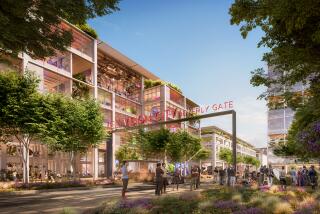Wal-Mart Talk Permeates ‘Power Center’ Debate
- Share via
SIMI VALLEY — It was talk of zoning and land use that dominated discussion Monday night as the City Council heard opinions from the public on plans to rezone a west-end tract for a “power center” of retail stores.
But beneath the civilized debate over whether Simi Valley needs more retail store space or more job-generating industries lay a hidden agenda.
And despite warnings from Mayor Greg Stratton that the topic was forbidden, it kept peeking through: The power center includes plans for a 135,000-square-foot Wal-Mart store.
“We all know that this whole zone change is about Wal-Mart,” resident Martin Banks said. “We all know this, so let’s call it as it is.”
At issue was whether developer Stan Rothbart can have a zoning change to build his power center on more than 45 acres of rolling hillsides if his plans include stores smaller than 70,000 square feet as well as the big Wal-Mart structure.
But the council has no power to approve or reject the giant retailer itself.
Wal-Mart could theoretically start construction in the west end tomorrow with nothing more elaborate than a set of city-approved plans and a bulldozer.
*
Residents, merchants and business people quickly split into two camps: those who welcome the new business, tax revenue and jobs they say the power center will bring, and those who fear it will kill all three.
“Let’s face it, we’re all shopping out of town for much of what we need now,” said Peggy Sadler, a Simi Valley resident for 33 years. “We’re going over the hill to Oxnard and Thousand Oaks and Ventura and the San Fernando Valley. . . . You don’t have a captive audience here, you have tremendous competition.” The power center would keep more Simi Valley shopping dollars in town, she said.
Jean Layton, another longtime resident, said bluntly: “In my opinion, we need a Wal-Mart here in Simi Valley. It would add tax revenue, which would pay for public projects. We do not need any more industrial areas.”
What’s more, Layton said, a discount store such as Wal-Mart would help older people like her, who live on fixed incomes.
And resident Judy Winzer pointed out that limiting competition by blocking the power center would deny local businesses the opportunity to profit from the increased shopping traffic such a center would bring. Although the Simi Valley Chamber of Commerce opposes the power center, she said that only 68 of its nearly 800 member businesses are retailers that would compete directly with Wal-Mart.
Then the power center’s opponents stepped up to the microphone.
Housing developer Gregory Clark rattled off the names of now-defunct “big box” shopping center anchors, such as Grossman’s and Gemco, which have tried and failed to survive in Simi Valley and hurt smaller businesses in the process.
Clark said of the proposed power center, “Its design and purpose is to kill shopping centers, and that means it kills neighborhood businesses.”
The debate wore on, at times punctuated by raucous applause, boos and hissing. Response was especially loud after Chamber of Commerce President Alan Rice and President-elect Dennis Barbee urged the council to leave the land alone so industrial businesses can bring much-needed high-paying jobs to the city.
“The Simi Valley Chamber of Commerce board, in a unprecedented unanimous vote, opposes any west-end land-use and zoning change that will reduce the available industrial land,” Rice said. “We believe in and we support the existing West End Specific Plan, based on the long-held belief that this community needs and must pursue and recruit employers.”
*
Some speakers cited a vote four years ago that shot down a proposed Wal-Mart. The chain sought to build one of its huge, general merchandise discount stores at the northern end of 1st Street, the site of an as-yet-unplanned regional shopping mall.
But voters vetoed it by rejecting Measure V in November 1993, a referendum that would have allowed the city’s hillside ordinances to be waived to allow Wal-Mart to build there.
More to Read
Inside the business of entertainment
The Wide Shot brings you news, analysis and insights on everything from streaming wars to production — and what it all means for the future.
You may occasionally receive promotional content from the Los Angeles Times.










